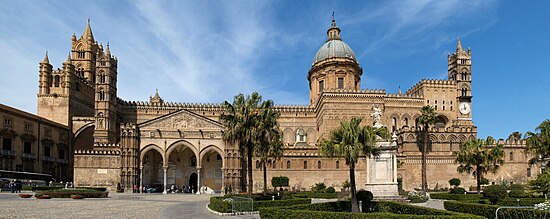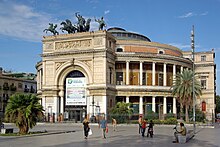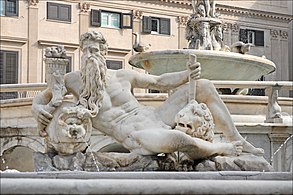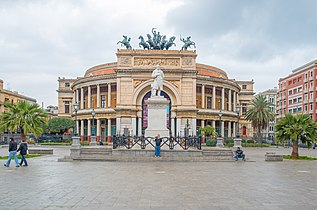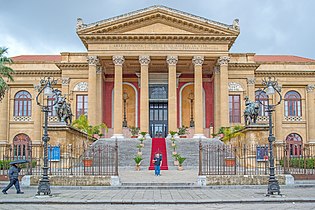Palermo
Palermo
Palermu (Sicilian) | |
|---|---|
| Comune di Palermo | |
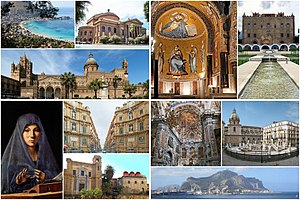 Clockwise from top: Mondello, Teatro Massimo, Cappella Palatina, Zisa, Cathedral, Virgin Annunciate of Antonello da Messina, Quattro Canti in Maqueda Street, Churches of Martorana and San Cataldo, Interior of Santa Caterina Church, Pretoria Square and Mount Pellegrino | |
 Flag  Coat of arms | |
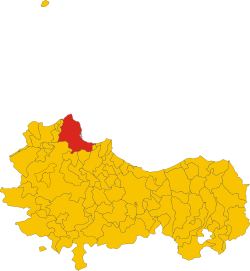 The municipality of Palermo within the Metropolitan City of Palermo | |
show Location of Palermo | |
 Palermo Location of Palermo in Sicily | |
| Coordinates: 38°07′N 13°22′E / 38.117°N 13.367°ECoordinates: 38°07′N 13°22′E / 38.117°N 13.367°E | |
| Country | Italy |
| Region | Sicily |
| Metropolitan city | Palermo (PA) |
| Founded | 736 BC |
| Government | |
| • Mayor | Leoluca Orlando (PD) |
| Area | |
| • Total | 158.9 km2 (61.4 sq mi) |
| Elevation | 14 m (46 ft) |
| Population (31 January 2013)[2] | |
| • Total | 676,118 (city) 1,300,000 (metro) |
| Demonym(s) | Palermitano Panormito Palermitan (English) |
| Time zone | UTC+1 (CET) |
| • Summer (DST) | UTC+2 (CEST) |
| Postal code | 90100 |
| Dialing code | 091 |
| ISTAT code | 082053 |
| Patron saint | Saint Rosalia, Saint Agata, Saint Oliva and Saint Benedict the Moor |
| Saint day | 14 July |
| Website | Official website |
Palermo (/pəˈlɛərmoʊ, -ˈlɜːr-/ pə-LAIR-moh, -LUR-,[3] Italian: [paˈlɛrmo] (![]() listen); Sicilian: Palermu [paˈlɛmmʊ], locally also Paliemmu or Palèimu;[4] Latin: Panormus, from Ancient Greek: Πάνορμος, romanized: Pánormos; older Arabic: بَلَرْم, romanized: Balarm) is a city in southern Italy, the capital of both the autonomous region of Sicily and the Metropolitan City of Palermo, the city's surrounding metropolitan province. The city is noted for its history, culture, architecture and gastronomy, playing an important role throughout much of its existence; it is over 2,700 years old. Palermo is in the northwest of the island of Sicily, by the Gulf of Palermo in the Tyrrhenian Sea.
listen); Sicilian: Palermu [paˈlɛmmʊ], locally also Paliemmu or Palèimu;[4] Latin: Panormus, from Ancient Greek: Πάνορμος, romanized: Pánormos; older Arabic: بَلَرْم, romanized: Balarm) is a city in southern Italy, the capital of both the autonomous region of Sicily and the Metropolitan City of Palermo, the city's surrounding metropolitan province. The city is noted for its history, culture, architecture and gastronomy, playing an important role throughout much of its existence; it is over 2,700 years old. Palermo is in the northwest of the island of Sicily, by the Gulf of Palermo in the Tyrrhenian Sea.
The city was founded in 734 BC by the Phoenicians as Ziz. Palermo then became a possession of Carthage. Two Greek colonies were established, known collectively as Panormos; the Carthaginians used this name on their coins after the 5th century BC. As Panormus, the town became part of the Roman Republic and Empire for over a thousand years. From 831 to 1072 the city was under Arab rule during the Emirate of Sicily when the city first became a capital. The Arabs shifted the Greek name into Balarm,[5][6] the root for Palermo's present-day name. Following the Norman conquest, Palermo became the capital of a new kingdom, the Kingdom of Sicily, that lasted from 1130 to 1816.[7]
The population of Palermo urban area is estimated by Eurostat to be 855,285, while its metropolitan area is the fifth most populated in Italy with around 1.2 million people. In the central area, the city has a population of around 676,000 people. The inhabitants are known as Palermitani or, poetically, panormiti. The languages spoken by its inhabitants are the Italian language and the Palermitano dialect of the Sicilian language.
Palermo is Sicily's cultural, economic and tourism capital. It is a city rich in history, culture, art, music and food. Numerous tourists are attracted to the city for its appealing Mediterranean climate, its renowned gastronomy[citation needed] and restaurants, its Romanesque, Gothic, Baroque[8] and Art Nouveau[9] churches, palaces and buildings, and its nightlife and music.[10] Palermo is the main Sicilian industrial and commercial center: the main industrial sectors include tourism, services, commerce and agriculture.[11] Palermo currently has an international airport, and a significant underground economy.[citation needed] In fact, for cultural, artistic and economic reasons, Palermo was one of the largest cities in the Mediterranean and in Europe and is now among the top tourist destinations in both Italy and Europe. It is the main seat of the UNESCO World Heritage Site Arab-Norman Palermo and the Cathedral Churches of Cefalù and Monreale. The city is also going through careful redevelopment, preparing to become one of the major cities of the Euro-Mediterranean area.[12]
Roman Catholicism is highly important in Palermitan culture. The Patron Saint of Palermo is Santa Rosalia whose Feast Day is celebrated on 15 July. The area attracts significant numbers of tourists each year and is widely known for its colourful fruit, vegetable and fish markets at the heart of Palermo, known as Vucciria, Ballarò and Capo.[13]
Geography[]
Palermo lies in a basin, formed by the Papireto, Kemonia and Oreto rivers. The basin was named the Conca d'Oro (the Golden Basin) by the Arabs in the 9th century. The city is surrounded by a mountain range which is named after the city itself. These mountains face the Tyrrhenian Sea. Palermo is home to a natural port and offers excellent views to the sea, especially from Monte Pellegrino.
Climate[]
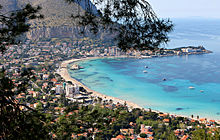
Palermo experiences a hot-summer subtropical Mediterranean climate (Köppen climate classification: Csa) with moderate seasonality. Summers are very long, hot and dry due to the domination of subtropical high pressure system, while winters are mild and changeable, with rainy weather due to the polar front.[14] Temperatures in autumn and spring are typically warm. Palermo is one of the warmest cities in Europe (mainly due to its warm nights), with an average annual air temperature of 18 °C (64 °F); it is one of the warmest cities in Italy. It receives approximately 2,530 hours of sunshine per year. Snow is a rare occurrence having snowed about a dozen times since 1945.[15] Since the 1940s to nowadays there have been at least five times when considerable snowfall has occurred. In 1949 and in 1956, when the minimum temperature went down to 0 °C (32 °F), the city was blanketed by some centimetres of snow.[16] Snowfalls also occurred in 1981, 1986, 1999 and 2014.[17] The average annual temperature of the sea is above 19 °C (66 °F); from 14 °C (57 °F) in February to 26 °C (79 °F) in August. In the period from November to May, the average sea temperature exceeds 18 °C (64 °F) and in the period from June to October, the average sea temperature exceeds 21 °C (70 °F).[18]
| hideClimate data for Palermo-Boccadifalco Airport on the outskirts of the city (altitude: 117 m, satellite view), 1971-2000 normals, Extremes 1943-present | |||||||||||||
|---|---|---|---|---|---|---|---|---|---|---|---|---|---|
| Month | Jan | Feb | Mar | Apr | May | Jun | Jul | Aug | Sep | Oct | Nov | Dec | Year |
| Record high °C (°F) | 27.2 (81.0) |
28.1 (82.6) |
34.6 (94.3) |
32.2 (90.0) |
39.1 (102.4) |
44.0 (111.2) |
43.6 (110.5) |
45.2 (113.4) |
41.2 (106.2) |
37.4 (99.3) |
30.3 (86.5) |
26.7 (80.1) |
45.2 (113.4) |
| Average high °C (°F) | 14.7 (58.5) |
14.5 (58.1) |
16.4 (61.5) |
18.7 (65.7) |
23.3 (73.9) |
27.2 (81.0) |
29.8 (85.6) |
30.5 (86.9) |
27.5 (81.5) |
23.5 (74.3) |
19.0 (66.2) |
15.8 (60.4) |
21.7 (71.1) |
| Daily mean °C (°F) | 11.8 (53.2) |
11.5 (52.7) |
13.0 (55.4) |
15.1 (59.2) |
19.3 (66.7) |
23.2 (73.8) |
25.7 (78.3) |
26.6 (79.9) |
23.8 (74.8) |
20.1 (68.2) |
15.9 (60.6) |
13.0 (55.4) |
18.3 (64.9) |
| Average low °C (°F) | 8.9 (48.0) |
8.5 (47.3) |
9.6 (49.3) |
11.4 (52.5) |
15.3 (59.5) |
19.2 (66.6) |
21.7 (71.1) |
22.7 (72.9) |
20.1 (68.2) |
16.7 (62.1) |
12.9 (55.2) |
10.2 (50.4) |
14.8 (58.6) |
| Record low °C (°F) | −1.2 (29.8) |
0 (32) |
−0.3 (31.5) |
4.6 (40.3) |
8.4 (47.1) |
11 (52) |
14.8 (58.6) |
13.1 (55.6) |
10.6 (51.1) |
7.2 (45.0) |
3.6 (38.5) |
0.8 (33.4) |
−1.2 (29.8) |
| Average precipitation mm (inches) | 97.5 (3.84) |
109.9 (4.33) |
78.2 (3.08) |
65.1 (2.56) |
36.2 (1.43) |
17.9 (0.70) |
6.7 (0.26) |
31.8 (1.25) |
65.3 (2.57) |
105.6 (4.16) |
117.5 (4.63) |
123.7 (4.87) |
855.4 (33.68) |
| Average precipitation days | 9.6 | 9.6 | 8.7 | 8.6 | 4.1 | 1.9 | 1.2 | 2.4 | 5.4 | 8.2 | 10.4 | 12 | 82.1 |
| Source 1: Servizio Meteorologico[19] | |||||||||||||
| Source 2: Tu Tiempo[20] Extreme temperatures. | |||||||||||||
| hideClimate data for Palermo-Valverde, elevation: 21 m or 69 ft, 1961-1990 normals, Extremes 1960-1990 | |||||||||||||
|---|---|---|---|---|---|---|---|---|---|---|---|---|---|
| Month | Jan | Feb | Mar | Apr | May | Jun | Jul | Aug | Sep | Oct | Nov | Dec | Year |
| Average high °C (°F) | 15.4 (59.7) |
15.9 (60.6) |
17.5 (63.5) |
20.1 (68.2) |
23.4 (74.1) |
27.2 (81.0) |
30.1 (86.2) |
30.4 (86.7) |
28.3 (82.9) |
24.5 (76.1) |
20.6 (69.1) |
16.9 (62.4) |
22.5 (72.5) |
| Daily mean °C (°F) | 11.1 (52.0) |
11.5 (52.7) |
12.7 (54.9) |
15.1 (59.2) |
18.2 (64.8) |
21.9 (71.4) |
24.6 (76.3) |
25.0 (77.0) |
23.1 (73.6) |
19.7 (67.5) |
15.9 (60.6) |
12.6 (54.7) |
17.6 (63.7) |
| Average low °C (°F) | 6.8 (44.2) |
7.0 (44.6) |
8.0 (46.4) |
10.1 (50.2) |
12.9 (55.2) |
16.6 (61.9) |
19.0 (66.2) |
19.6 (67.3) |
17.9 (64.2) |
14.8 (58.6) |
11.3 (52.3) |
8.4 (47.1) |
12.7 (54.9) |
| Average precipitation mm (inches) | 89 (3.5) |
69 (2.7) |
58 (2.3) |
46 (1.8) |
25 (1.0) |
10 (0.4) |
5 (0.2) |
12 (0.5) |
42 (1.7) |
80 (3.1) |
84 (3.3) |
93 (3.7) |
613 (24.2) |
| Average precipitation days | 12 | 9 | 9 | 7 | 4 | 2 | 1 | 1 | 5 | 8 | 10 | 12 | 80 |
| Source: Servizio Meteorologico[21] | |||||||||||||
| hideClimate data for Cinisi, at 30 kilometres (19 mi) from Palermo. (Palermo Punta Raisi Airport), elevation: 21 m or 69 ft, 1961-1990 normals, Extremes 1960-1990 | |||||||||||||
|---|---|---|---|---|---|---|---|---|---|---|---|---|---|
| Month | Jan | Feb | Mar | Apr | May | Jun | Jul | Aug | Sep | Oct | Nov | Dec | Year |
| Record high °C (°F) | 25.6 (78.1) |
29.4 (84.9) |
34.7 (94.5) |
34.6 (94.3) |
40.0 (104.0) |
44.2 (111.6) |
43.1 (109.6) |
42.4 (108.3) |
40.6 (105.1) |
35.2 (95.4) |
31 (88) |
26.7 (80.1) |
44.2 (111.6) |
| Average high °C (°F) | 14.8 (58.6) |
15.1 (59.2) |
16.1 (61.0) |
18.4 (65.1) |
21.8 (71.2) |
25.1 (77.2) |
28.3 (82.9) |
28.8 (83.8) |
26.6 (79.9) |
22.9 (73.2) |
19.3 (66.7) |
16.0 (60.8) |
21.1 (70.0) |
| Daily mean °C (°F) | 12.5 (54.5) |
12.6 (54.7) |
13.5 (56.3) |
15.7 (60.3) |
18.9 (66.0) |
22.4 (72.3) |
25.6 (78.1) |
26.2 (79.2) |
24.1 (75.4) |
20.3 (68.5) |
16.8 (62.2) |
13.7 (56.7) |
18.5 (65.4) |
| Average low °C (°F) | 10.2 (50.4) |
10.1 (50.2) |
10.9 (51.6) |
12.9 (55.2) |
16.0 (60.8) |
19.7 (67.5) |
22.9 (73.2) |
23.6 (74.5) |
21.5 (70.7) |
17.8 (64.0) |
14.3 (57.7) |
11.5 (52.7) |
16.0 (60.7) |
| Record low °C (°F) | 1.4 (34.5) |
2.4 (36.3) |
2.4 (36.3) |
5.8 (42.4) |
9 (48) |
13.3 (55.9) |
16 (61) |
17.9 (64.2) |
13 (55) |
8 (46) |
5.1 (41.2) |
1.6 (34.9) |
1.4 (34.5) |
| Average precipitation mm (inches) | 71.6 (2.82) |
65.4 (2.57) |
59.5 (2.34) |
44.1 (1.74) |
25.5 (1.00) |
12.2 (0.48) |
5.1 (0.20) |
13.3 (0.52) |
41.5 (1.63) |
98.0 (3.86) |
94.3 (3.71) |
80.0 (3.15) |
610.5 (24.02) |
| Average precipitation days | 10 | 10 | 9 | 6 | 3 | 2 | 1 | 2 | 4 | 8 | 9 | 11 | 75 |
| Average relative humidity (%) | 73 | 72 | 72 | 72 | 72 | 71 | 69 | 71 | 72 | 71 | 70 | 73 | 72 |
| Source 1: NOAA[22] | |||||||||||||
| Source 2: Altervista[23] Extreme temperatures. | |||||||||||||
Topography[]

Palermo is surrounded by mountains, which form a cirque around the city. Some districts of the city are divided by the mountains themselves. Historically, it was relatively difficult to reach the inner part of Sicily from the city because of the mounts. The tallest peak of the range is La Pizzuta, about 1,333 metres (4,373 ft) high. However, historically, the most important mount is Monte Pellegrino, which is geographically separated from the rest of the range by a plain. The mount lies right in front of the Tyrrhenian Sea. Monte Pellegrino's cliff was described in the 19th century by Johann Wolfgang von Goethe, as "the most beautiful promontory in the world", in his essay "Italian Journey".
Rivers[]
Today both the river and the are covered up by buildings. However, the shape of the former watercourses can still be recognised today, because the streets that were built on them follow their shapes. Today the only waterway not drained yet is the Oreto river that divides the downtown of the city from the western uptown and the industrial districts. In the basins there were, though, many seasonal torrents that helped formed swampy plains, reclaimed during history; a good example of which can be found in the borough of Mondello.
Districts[]

| Municipality | Quarters |
|---|---|
| I | Kalsa, Albergheria, Seralcadio & La Loggia |
| II | Settecannoli, Brancaccio & Ciaculli-Oreto |
| III | Villagrazia-Falsomiele & Stazione-Oreto |
| IV | Montegrappa, S. Rosalia, Cuba, Calafatimi, Mezzomonreale, Villa Tasca-Altarello & Boccadifalco |
| V | Zisa, Noce, Uditore-Passo di Rigano & Borgo Nuovo |
| VI | Cruillas, S. Giovanni Apostolo, Resuttana & San Lorenzo |
| VII | Pallavicino, Tommaso Natale, Sferracavallo, Partanna Mondello, Arenella, Vergine Maria & San Filippo Neri (formerly known as ZEN) |
| VIII | Politeama, Malaspina-Palagonia, Libertà & Monte Pellegrino |
Shown above are the thirty five quarters of Palermo: these thirty five neighbourhoods or "quartiere" as they are known, are further divided into eight governmental community boards.[24]
Landmarks[]
Palermo has a large architectural heritage and is notable for its many Norman buildings.
Palaces and museums[]

- Palazzo dei Normanni (the Norman Palace), a notable example of Norman architecture, this palace houses the Cappella Palatina.
- Zisa (1160) and Cuba, magnificent castles/houses historically used by the kings of Palermo for hunting. The Zisa today houses the Islamic museum. The Cuba was once encircled by water.
- Palazzo Natoli
- Palazzo Chiaramonte
- Palazzo Abatellis. Built at the end of the 15th century for the prefect of the city, Francesco Abatellis. It is a massive though elegant construction, in typical Catalan Gothic style, with Renaissance influences. The Gallery houses an Eleonora of Aragon bust by Francesco Laurana (1471) and the Malvagna Triptych (c. 1510), by Jan Gossaert and the famous Annunziata by Antonello da Messina.
- The Regional Archeological Museum Antonio Salinas is one of the main museums of Italy: it includes numerous remains from Etruscan, Carthaginian, Roman and Hellenistic civilisations. It houses all the decorative remains from the Sicilian temples of Segesta and Selinunte.
- Palazzina Cinese, royal residence of the House of Bourbon-Two Sicilies and location of the Ethnografic Museum of Sicily.
Churches[]


- Palermo Cathedral: Located at Corso Vittorio Emanuele, corner Via Matteo Bonello, its long history has led to an accumulation of different architectural styles, the latest being the 18th century.
- Cappella Palatina, the 12th century chapel of the Palazzo dei Normanni, has outstanding mosaics in both Western and the Eastern traditions and a roof by Saracen craftsmen.
- San Giovanni dei Lebbrosi
- San Giovanni degli Eremiti (St. John of the Hermit Order): Located near the Palazzo dei Normanni, a 12th-century church notable for its bright red domes, a remnant of Arab influence in Sicily. In his Diary of an Idle Woman in Sicily, F. Elliot described it as "... totally oriental... it would fit well in Baghdad or Damascus". The bell tower is an example of Norman architecture.
- Chiesa della Martorana: Also known as Santa Maria dell'Ammiraglio (St Mary of the Admiral), the church is annexed to the next-door church of San Cataldo and overlooks the Piazza Bellini in central Palermo. The original layout was a compact cross-in-square ("Greek cross plan"), a common south Italian and Sicilian variant of the middle Byzantine period church style. Three eastern apses adjoin directly to the naos, instead of being separated by an additional bay, as was usual in eastern Byzantine architecture.[25] The bell tower, lavishly decorated, still serves as the main entrance to the church. The interior decoration is elaborate, and includes Byzantine mosaics.
- San Cataldo: Church, on the central Piazza Bellini, which is a good example of Norman architecture.
- Santa Maria della Gancia
- Santa Caterina: This church is located behind Piazza Pretoria and built between 1566 and 1596 in the baroque style.
- Santa Maria della Catena: This church was built between 1490 and 1520. Designed by Matteo Carnilivari: The name derives from chains that were once attached to one of the walls.
- San Domenico: Located near , it is known as the “Pantheon of illustrious Sicilians”.
- San Giuseppe dei Teatini: Located near the Quattro Canti, it is an example of Sicilian Baroque.
- Oratorio di San Lorenzo Working in stucco, Rococo sculptor Giacomo Serpotta, his brother Giuseppe and his son Procopio, decorated the church (1690/98–1706) with such a profusion of statuary, and an abundance of putti, the walls appear alive. In October 1969, two thieves removed Caravaggio's Nativity with St. Francis and St. Lawrence from its frame. It has never been recovered.[26][27]
- : Completed by Giacomo Serpotta in (1710–17)
- Santa Teresa alla Kalsa, which derives its name from Al-Khalisa, an Arabic term meaning elected, was constructed between 1686 and 1706 over the former Emir's residence, is one of the best examples of Sicilian Baroque. It has a single, airy nave, with stucco decorations from the early 18th century.
- Santa Maria dello Spasimo was built in 1506 and later turned into a hospital. This church inspired Raphael to paint his famous Sicilia's Spasimo, now in the Museo del Prado. The church today is a fascinating open-air auditorium, which occasionally houses exhibitions and musical shows.
- Church of the Gesu (Church of Jesus): Located in the city centre, the church was built in 1564 in the late-Renaissance style by the Jesuits. It was built over a pre-existing convent of Basilian monks. Alterations in 1591 were completed in a Sicilian Baroque. The church was heavily damaged after the 1943 bombings, which destroyed most of the frescos. The interior has a Latin cross plan with a nave and two aisles, and has a particularly rich decoration of marbles, intarsia and stuccoes, especially in St Anne's Chapel. At the right is the Casa Professa, with a 1685 portal and a precious 18th century cloister. The building has been home to the Municipal Library since 1775.
- San Francesco di Assisi: this church was built between 1255 and 1277 in what was once the market district of the city, at the site of two pre-existing churches and was largely renovated in the 15th, 16th, 18th and 19th centuries, the last after an earthquake. After the 1943 bombings, the church was restored to its Medieval appearance, which now includes part of the original building such as part of the right side, the apses and the Gothic portal in the façade. The interior has a typical Gothic flavour, with a nave and two aisles separated by two rows of cylindrical pilasters. Some of the chapels are in Renaissance style, as well as the late 16th century side portals. The church includes precious sculptures by Antonio, Giacomo Gagini and Francesco Laurana. Of note are also statues built by Giacomo Serpotta in 1723.
- Church of the Magione: Officially known as the church of the Holy Trinity. This church was built in the Norman style in 1191 by Matteo d'Ajello, who donated it to the Cistercian monks.
Squares and public monuments[]
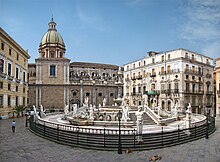
- Quattro Canti is a small square at the crossing of the ancient main roads (now: Corso Vittorio Emanuele and Via Maqueda) dividing the town into its quarters (mandamenti). The buildings at the corner have diagonal baroque façades so the square has an almost octagonal form.
- Piazza Pretoria was planned in the 16th century near the Quattro Canti as the site of a fountain by Francesco Camilliani, the Fontana Pretoria.
- The monument to Charles V on Piazza Bologni, erected in 1631.
City walls[]
Palermo has at least two rings of city walls, many pieces of which still survive. The first ring surrounded the ancient core of the Phoenician city – the so-called Palaeopolis (in the area east of Porta Nuova) and the Neapolis. Via Vittorio Emanuele was the main road east–west through this early walled city. The eastern edge of the walled city was on Via Roma and the ancient port in the vicinity of Piazza Marina. The wall circuit was approximately Porto Nuovo, Corso Alberti, Piazza Peranni, Via Isodoro, Via Candela, Via Venezia, Via Roma, Piazza Paninni, Via Biscottari, Via Del Bastione, Palazzo dei Normanni and back to Porto Nuovo.
In the medieval period the walled city was expanded. Via Vittorio Emanuele continued to be the main road east–west through the walled city. The west gate was still Porta Nuova, the walls continued to Corso Alberti, to Piazza Vittorio Emanuele Orlando where it turned east along Via Volturno to Piazza Verdi and along the line of Via Cavour. At this northeast corner there was a defence, Castello a Mare, to protect the port at La Cala. A huge chain was used to block La Cala with the other end at Santa Maria della Catena (St Mary of the Chain). The sea-side wall was along the western side of Foro Italico Umberto. The wall turns west along the northern side of Via Abramo Lincoln, continues along Corso Tukory. The wall turns north approximately on Via Benedetto, to Palazzo dei Normanni and back to Porta Nuova.[28]
Several gates in the city wall survive. Images of the wall can be seen here.[29]
Opera houses[]

Up until the beginning of 20th century there were hundreds of small opera theatres known as magazzeni in the city of Palermo.
- The Teatro Massimo ("Greatest Theatre") was opened in 1897. It is the biggest in Italy (8,000 m2, 86,000 sq ft), and one of the largest of Europe (the third after the Paris Opera and the Vienna State Opera), renowned for its perfect acoustics. Enrico Caruso sang in a performance of La Gioconda during the opening season, returning for Rigoletto at the very end of his career. Closed for renovation from 1974 until 1997, it is now restored and has an active schedule.
- The Teatro Politeama was built between 1867 and 1874.
Other sights[]
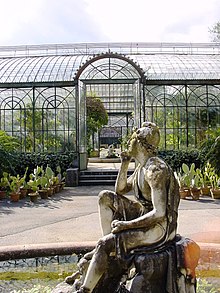
The cathedral has a heliometer (solar observatory) dating to 1690, one of a number[30] built in Italy in the 17th and 18th centuries. The device itself is quite simple: a tiny hole in one of the minor domes acts as pinhole camera, projecting an image of the sun onto the floor at solar noon (12:00 in winter, 13:00 in summer). There is a bronze line, la Meridiana, on the floor, running precisely north–south. The ends of the line mark the positions as at the summer and winter solstices; signs of the zodiac show the various other dates throughout the year.
The purpose of the instrument was to standardise the measurement of time and the calendar. The convention in Sicily had been that the (24‑hour) day was measured from the moment of dawn, which of course meant that no two locations had the same time and, more importantly, did not have the same time as in St. Peter's Basilica in Rome. It was also important to know when the vernal equinox occurred, to provide the correct date for Easter.
The Orto botanico di Palermo (Palermo Botanical Garden), founded in 1785, is the largest in Italy with a surface of 10 hectares (25 acres).
One site of interest is the Capuchin Catacombs, with many mummified corpses in varying degrees of preservation.
Close to the city is the 600-metre-high (2,000 ft) Monte Pellegrino, offering a panorama of the city, its surrounding mountains and the sea.
Another good panoramic viewpoint is the promontory of Monte Gallo (586 m, 1,923 ft), near Mondello Beach.[31]
Moreton Bay fig of >30 m girth and of 32m height can be found on the Piazza Marina. This Ficus macrophylla is most probably the thickest tree in Europe.[32]
On the boulevard Via Roma is the Palazzo delle Poste an official Italian government building created during the Mussolini era in the stripped classicism architectural style. It was designed by the rationalist and later fascist government architect, Angiolo Mazzoni. Perhaps its most famous feature is the five mural cycle in the Futurist style painted by the artist Benedetta Cappa titled "Sintesi delle Comunicazioni" (Synthesis of Communication.[33][34]
UNESCO World Heritage Sites[]
UNESCO World Heritage Sites include the Palazzo Reale with the Cappella Palatina, the Chiesa di San Giovanni degli Eremiti, the Chiesa di Santa Maria dell’Ammiraglio, the Chiesa di San Cataldo, the Cattedrale di Palermo, the Palazzo della Zisa and the Ponte dell’Ammiraglio,[35][36][37] adding to the list that makes Italy the country with most UNESCO world heritage sites.[38][39][40]
Demographics[]
| Year | Pop. | ±% |
|---|---|---|
| 1861 | 199,911 | — |
| 1871 | 223,689 | +11.9% |
| 1881 | 244,898 | +9.5% |
| 1901 | 309,566 | +26.4% |
| 1911 | 339,465 | +9.7% |
| 1921 | 397,486 | +17.1% |
| 1931 | 379,905 | −4.4% |
| 1936 | 411,879 | +8.4% |
| 1951 | 490,692 | +19.1% |
| 1961 | 587,985 | +19.8% |
| 1971 | 642,814 | +9.3% |
| 1981 | 701,782 | +9.2% |
| 1991 | 698,556 | −0.5% |
| 2001 | 686,722 | −1.7% |
| 2008 (Est.) | 659,623 | −3.9% |
| Source: ISTAT 2001 | ||
In 2010, there were 1.2 million people living in the greater Palermo area, 655,875 of which resided in the City boundaries, of whom 47.4% were male and 52.6% were female. People under age 15 totalled 15.6% compared to pensioners who composed 17.2% of the population. This compares with the Italian average of 14.1% people under 15 years and 20.2% pensioners. The average age of a Palermo resident is 40.4 compared to the Italian average of 42.8. In the ten years between 2001 and 2010, the population of Palermo declined by 4.5%, while the population of Italy, as a whole, grew by 6.0%. The reason for Palermo's decline is a population flight to the suburbs, and to Northern Italy.[41] The current birth rate of Palermo is 10.2 births per 1,000 inhabitants compared to the Italian average of 9.3 births.
As of 2006, 97.79% of the population was of Italian descent. The largest immigrant group came from South Asia (mostly from Bangladesh and Sri Lanka): 0.80%, other European countries (mostly from Albania, Romania, Serbia, North Macedonia and Ukraine): 0.3%, and North Africa (mostly from Tunisia): 0.28%.[42]
| Country of birth | Population |
|---|---|
| 5,567 | |
| 3,846 | |
| 3,056 | |
| 2,803 | |
| 1,757 | |
| 1,295 | |
| 1,184 | |
| 1,135 | |
| 1,034 | |
| 1,026 | |
| other countries | each <600 |
History[]
Early history[]

Evidence of human settlement in the area now known as Palermo goes back to at least the Mesolithic period, perhaps around 8000 BC, where a group of cave drawings at nearby Addaura from that period have been found.[44] The original inhabitants were Sicani people who, according to Thucydides, arrived from the Iberian Peninsula (perhaps Catalonia).[45][46]
Antiquity[]

In 734 BC the Phoenicians, maritime traders from northern Canaan, built a small settlement on the natural harbor of Palermo, which became known as Ziz[47] (Punic:




